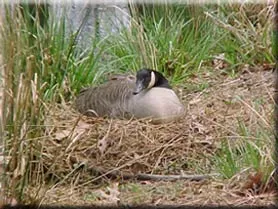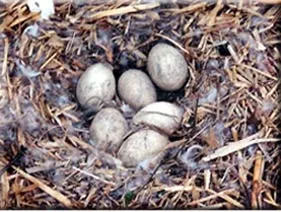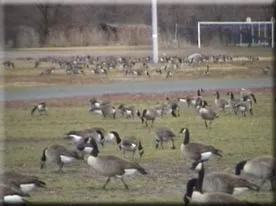Canada geese (Branta canadensis) are iconic waterfowl known for their distinctive V-shaped flocks during migration and adaptability to both wild and urban environments. These large birds, particularly the giant Canada goose subspecies common in the Midwest, have made a remarkable recovery from near-extinction. If you’re fascinated by wildlife, understanding Canadian geese mating behavior and their life cycle offers insights into their resilience and ecological role. This guide covers everything from physical traits and nesting habits to feeding patterns and population trends, drawing from authoritative wildlife surveys.
Quick Facts About Canada Geese
Here’s an at-a-glance overview of the Canada goose:
- Height: 20–48 inches
- Weight: 3–24 pounds (giant subspecies averages 12 pounds)
- Lifespan: Average 10–25 years; up to 42 years in captivity
- Flight Speed: 10–50 MPH
- Range: Most of continental U.S., Canada, northern Mexico (winter)
- Habitats: Wetlands, ponds, lakes, rivers, coastal areas, urban basins
- Diet: Grains, succulents, forbs, grasses, pondweeds, urban lawns
These stats highlight why Canada geese thrive across diverse landscapes, from rural farmlands to city parks.
 Canada goose nest in natural habitat
Canada goose nest in natural habitat
Description and General Behavior
The Canada goose ranks among the largest waterfowl species. The giant Canada goose (Branta canadensis maxima), which breeds in areas like Indiana, was once thought extinct due to unregulated hunting and habitat loss before European settlement. In 1962, Dr. Harold Hanson of the Illinois Natural History Survey rediscovered remnant populations wintering in Rochester, Minnesota. Conservation efforts by agencies re-established flocks across the Midwest. Today, they nest statewide, with major populations in Indianapolis, northern Indiana, southwestern coal lands, and state wildlife areas.
Size varies across seven North American subspecies, from 3 to 24 pounds. Indiana breeders are primarily giants, while smaller migrants pass through seasonally. Adults feature grayish-brown wings, backs, sides, and breasts; black tails, feet, legs, bills, and heads; and long black necks with white cheek patches. Males are larger than females, but plumage is identical. Goslings hatch light yellow with greenish-gray heads, darkening to adult colors by 70 days when they fledge.
Lifespans average 10–25 years in the wild, with some exceeding 30 years and one captive record over 40. Their adaptability has led to booming urban populations, where they frequent retention ponds and lawns.
Nesting and Breeding Habits
Canada geese typically pair at age 3 (sometimes 2) and mate for life, quickly replacing lost partners. In Indiana, pairs form in mid- to late February, with nesting from mid-March to late April.
Nests are within 150 feet of water, in concealed spots like islands, muskrat houses, artificial platforms, shoreline vegetation, tree bases, shrubs, cattails, urban landscaping, or rooftops. Both parents defend the site fiercely.
The female lays one egg every 1.5 days, averaging 5 per clutch (2–12 possible), in a 12–40-inch bowl of plants and breast feathers. Incubation lasts 28 days, with all eggs hatching synchronously. Goslings leave the nest within 24 hours, led by adults. Failed early nests prompt renesting nearby; late failures rarely do.
Parents protect broods for 10–12 weeks, forming “gang broods” of 20–100 goslings in dense areas. Families, including prior offspring, stay together into winter.
 Canada goose eggs in a nest
Canada goose eggs in a nest
Both breeders exhibit strong site fidelity, contributing to population stability. Wildlife experts note that urban nesting success benefits from low predation, though it poses management challenges.
Feeding Patterns
 Canada geese grazing on grass
Canada geese grazing on grass
As grazers, Canada geese are mostly vegetarian, occasionally eating fish or invertebrates. Fall and winter diets focus on high-calorie waste grains in harvested fields (corn, wheat, soybeans), grazed mornings and afternoons without yield loss in winter wheat. Summer menus include aquatic plants, succulents, forbs, and grasses—urban favorites like fertilized bluegrass lawns.
They prefer open feeding areas for predator vigilance, explaining their presence on golf courses, parks, and pastures.
Molting Period
Waterfowl like Canada geese undergo a full flight-feather molt annually, rendering them flightless for about a month. In Indiana, this peaks late June to early July. Non-breeders molt first, followed by parents post-hatch, timing flight recovery with gosling fledging at 70 days.
They choose open, watery sites near food, such as farm ponds, pastures, mowed lawns, or urban parks, minimizing vulnerability.
Migration and Movements
Famous for V-formations, Canada geese migrate south in fall and north in spring. Indiana’s “resident” giants disperse widely—banding data shows harvests in 40 states/provinces—though different birds occupy areas seasonally.
Northern subspecies (e.g., interior Canada goose) migrate farther, pushed by deep snow. They may winter in southern Wisconsin or central Indiana/Illinois, rarely farther south. Balancing harvest protection for migrants versus local control for giants remains key to management.
Mortality Factors
Adult survival exceeds 90% for Indiana breeders (70% for interiors). First-year goslings face higher risks from predation, hunting, disease, starvation, vehicles, and power lines. Urban low-predation areas boost juvenile survival, inflating populations.
Population Trends
Indiana’s breeding population stabilized around 102,500 since 1999 (goal: 80,000; current ~113,000), excluding migrants. Fluctuations tie to late-spring flooding destroying nests, as in 2012–2013 drops from 110,000 to 82,000. Recovery demonstrates effective conservation.
In summary, Canada geese exemplify wildlife adaptability, from nesting ingenuity to dietary flexibility. Their recovery underscores successful habitat restoration. For deeper insights, consult local wildlife agencies or observe responsibly—share your sightings in the comments below!
References
- Indiana Department of Natural Resources (DNR) Fish and Wildlife: Canada Goose Management
- Illinois Natural History Survey studies by Dr. Harold Hanson (1962)
